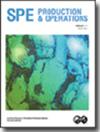Surrogate-Based Prediction and Optimization of Multilateral Inflow Control Valve Flow Performance with Production Data
IF 1.3
4区 工程技术
Q2 ENGINEERING, PETROLEUM
引用次数: 3
Abstract
Smart completions enable physical measurements over space and time, which provides large volumes of information at unprecedented rates. However, optimizing inflow control valve (ICV) settings of smart multilateral wells is a challenging task. Traditionally, ICV field tests, evaluating well performance at different ICV settings, are conducted to observe flow behavior and configure ICVs; however, this is often suboptimal. This study investigated a surrogate-based optimization algorithm that minimizes the number of ICV field tests required, predicts well performance of all unseen combination of ICV settings, and determines the optimal ICV setting and net present value (NPV). A numerical model of a real offshore field in Saudi Arabia was used to generate scenarios involving a two-phase (oil and water) reservoir with trilateral producers. Multiple scenarios were examined with variations in design parameters, mainly well count, placement, and configuration. Eight discrete settings were assumed to match the commonly installed ICV technology, where all possible scenarios were simulated to establish ground truth. The investigation considered three major algorithmic components: sampling, machine learning, and optimization. The sampling strategy compared physics-based initialization, space-filling sampling, and triangulation-based adaptive sampling. A cross-validated neural network was used to fit a surrogate (in this case, machine learning algorithm) dynamically, whereas enumeration was adopted for optimization to avoid errors arising from using common optimizers. This study evaluated two sampling techniques: space-filling and adaptive sampling. The latter was found superior in capturing reservoir behavior with the smallest number of simulation runs (i.e., ICV field tests). Algorithm performance was evaluated based on the number of ICV field tests required to exceed an R2 threshold of 90% on all unseen scenarios and match the optimal ICV settings and NPV. Surface and downhole flow profile prediction and optimization were achieved successfully using this approach. To determine the diminishing value of additional ICV field tests, the triangulation sampling loss was used as a stoppage criterion. When running the algorithm on a single producer for both surface and downhole oil and water flow prediction, the algorithm required only 6 and 11 ICV field tests to achieve 80% and 90% R2 across the different cases of this real reservoir model. Fishbone wellbore configurations were found to pose a more challenging task because changes in any ICV pressure decrease affects multiple laterals simultaneously, which increases the level of interdependence. The resultant surrogate was used to decide on the optimal settings of ICV devices and effectively predict the NPV. Surrogates, in this approach, are statistical proxies of the targeted ground-truth production function. Further improvement was accomplished through adaptively sampling and fitting surrogates to predict NPV explicitly, where NPV predictions were generated with nearly 95% R2 given only 10 ICV field tests. Using adaptive sampling and machine learning proved effective in the prediction of surface and downhole flow profiles and optimization of smart wells. The method further allows for dynamically optimizing field strategy in a reinforcement learning setting where production data are used continuously to further improve the prediction performance.基于代理的多边流入控制阀流量性能预测与优化
智能完井能够在空间和时间上进行物理测量,从而以前所未有的速度提供大量信息。然而,优化智能多边井的流入控制阀(ICV)设置是一项具有挑战性的任务。传统上,进行ICV现场测试,评估不同ICV设置下的井性能,以观察流动行为并配置ICV;然而,这通常是次优的。本研究研究了一种基于代理的优化算法,该算法可以最大限度地减少所需的ICV现场测试次数,预测所有看不见的ICV设置组合的良好性能,并确定最佳ICV设置和净现值(NPV)。沙特阿拉伯真实海上油田的数值模型被用于生成涉及具有三边生产商的两相(石油和水)油藏的场景。在设计参数变化的情况下,对多个场景进行了检查,主要是井数、位置和配置。假设八个离散设置与通常安装的ICV技术相匹配,在该技术中模拟所有可能的场景以确定地面实况。该调查考虑了三个主要的算法组成部分:采样、机器学习和优化。采样策略比较了基于物理的初始化、空间填充采样和基于三角测量的自适应采样。交叉验证的神经网络用于动态拟合代理(在本例中为机器学习算法),而枚举用于优化,以避免使用常见优化器时出现错误。本研究评估了两种采样技术:空间填充和自适应采样。后者在模拟运行次数最少(即ICV现场测试)的情况下捕捉储层动态方面表现出色。算法性能是根据在所有看不见的场景中超过90%的R2阈值并匹配最佳ICV设置和NPV所需的ICV现场测试次数进行评估的。该方法成功地实现了地面和井下流动剖面的预测和优化。为了确定附加ICV现场测试的递减值,使用三角测量采样损失作为停止标准。当在单个生产商上运行该算法用于地表和井下油水流预测时,该算法只需要6次和11次ICV现场测试,就可以在该真实储层模型的不同情况下实现80%和90%的R2。鱼骨井眼配置被发现是一项更具挑战性的任务,因为任何ICV压力下降的变化都会同时影响多个分支,这会增加相互依赖的程度。由此产生的代理用于决定ICV设备的最佳设置并有效预测NPV。在这种方法中,代理是目标地面实况生成函数的统计代理。通过自适应采样和拟合替代物来明确预测NPV,实现了进一步的改进,其中在仅进行10次ICV现场测试的情况下,NPV预测产生了近95%的R2。事实证明,使用自适应采样和机器学习在预测地表和井下流量剖面以及优化智能井方面是有效的。该方法还允许在强化学习设置中动态优化现场策略,其中连续使用生产数据来进一步提高预测性能。
本文章由计算机程序翻译,如有差异,请以英文原文为准。
求助全文
约1分钟内获得全文
求助全文
来源期刊

Spe Production & Operations
工程技术-工程:石油
CiteScore
3.70
自引率
8.30%
发文量
54
审稿时长
3 months
期刊介绍:
SPE Production & Operations includes papers on production operations, artificial lift, downhole equipment, formation damage control, multiphase flow, workovers, stimulation, facility design and operations, water treatment, project management, construction methods and equipment, and related PFC systems and emerging technologies.
 求助内容:
求助内容: 应助结果提醒方式:
应助结果提醒方式:


